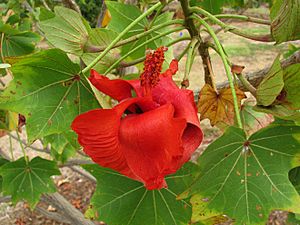Kokia cookei facts for kids
Quick facts for kids Kokia cookei |
|
|---|---|
 |
|
| Conservation status | |
| Scientific classification | |
| Genus: |
Kokia
|
| Species: |
cookei
|
Kokia cookei is a special kind of small tree. It loses its leaves every year, just like some trees in colder places. People also call it the kokiʻo, Molokaʻi treecotton, Cooke's kokiʻo, or Molokaʻi kokiʻo. This tree is very rare and is only found on the island of Molokaʻi in Hawaii.
Contents
Where the Kokiʻo Lives
This amazing tree only grew in the lowlands of western Molokaʻi island. This is part of the Hawaiian Islands. It probably lived in dry forests on the western side of the island. This area gets less rain.
Around the year 1000 CE, Polynesian settlers arrived. They cut down most of these forests to grow food. But the kokiʻo tree was likely noticed by them. Its native Hawaiian name, hau heleʻula, means "entirely red hau". The first three kokiʻo trees found by scientists grew near Mahana. This area is northeast of Puu Nana, about 200 meters (656 feet) high.
Even though the original forests were destroyed, the Molokaʻi kokiʻo survived for a while. It could handle some changes to its home. This helped it last until the 1800s.
Why the Kokiʻo is so Rare
The Molokaʻi kokiʻo is one of the rarest and most endangered plants in the world. When it was first found in the 1860s, only three trees existed. People thought it was extinct in the 1950s. That's because the last known young plant died.
But in 1970, a single kokiʻo tree was found! It was on the same land where the "last" one had grown. Sadly, this tree was destroyed in a fire in 1978. Luckily, a branch had been taken from it earlier. This branch was grafted onto a related tree, the Kokia kauaiensis. Grafting is like attaching a part of one plant to another so they grow together. Today, there are about 23 grafted kokiʻo plants.
Birds That Helped the Kokiʻo Grow
The kokiʻo likely became extinct in the wild because the birds that helped it reproduce disappeared. These birds are called nectarivorous birds. They drink nectar from flowers. K. cookei flowers are shaped to be pollinated by birds. Pollination is how plants make seeds.
The birds that helped the kokiʻo were Hawaiian honeycreepers. They were removed from the dry forests by the Polynesians. Later, many of the remaining birds died from diseases. These diseases, like avian malaria, were carried by mosquitoes in the 1800s.
The Molokaʻi kokiʻo has wide, large flowers. This means many different birds could have pollinated it. Here are some of the birds that might have helped:
- Maui Nui ʻalauahio – This bird is gone from the island.
- Kākāwahie – This bird disappeared from the lowlands by 1900 and is now extinct.
- Common ʻamakihi – This bird also disappeared from the lowlands by 1900.
- ʻIʻiwi – This bird disappeared from the lowlands by 1900.
- Black mamo – This bird is extinct. It's not certain if it lived in the kokiʻo's habitat often.
- ʻApapane – This bird disappeared from the lowlands by 1900.
- ʻAkohekohe – This bird is gone from the island. It's not certain if it lived in the kokiʻo's habitat often.
The ʻIʻiwi was probably the most important pollinator. The other birds were either too small or had short beaks for the kokiʻo's large flowers. Also, some of them might not have lived in the kokiʻo's area very much.
See also
 In Spanish: Kokia cookei para niños
In Spanish: Kokia cookei para niños


